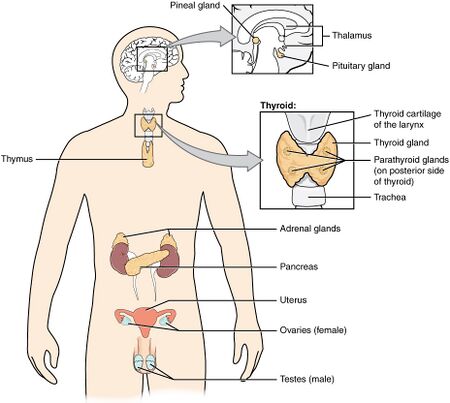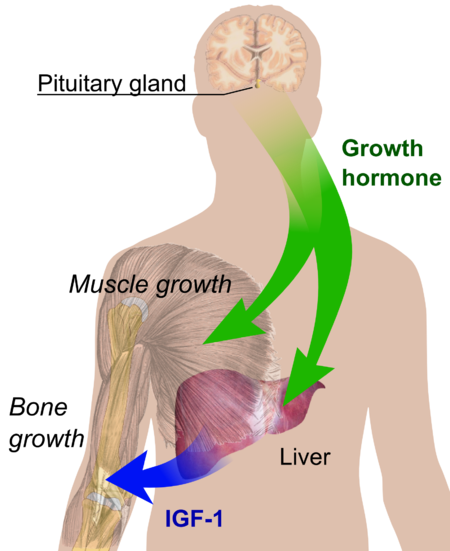Endocrine System

The endocrine system is a network of glands and organs located throughout the body. It’s similar to the nervous system in that it plays a vital role in controlling and regulating many of the body’s functions.
While the nervous system uses nerve impulses and neurotransmitters for communication, the endocrine system uses chemical messengers called hormones. [1]
Glands [ edit | edit source ]

Unlike exocrine glands (sweat, salivary), endocrine glands secrete their respective substances directly into the bloodstream rather than through a duct. These endocrine glands belong to the body’s control system and they produce hormones which help to regulate the functions of cells and tissues. The endocrine system involves many organ systems and hormones, many of which are still being investigated and understood.
The major glands of the endocrine system are the listed below:
- Hypothalamus: responsible for creating or controlling many hormones in the body. The hypothalamus works with the pituitary gland, which makes and sends other important hormones around the body. Together, the hypothalamus and pituitary gland control many of the glands of the endocrine system. This includes the adrenal cortex, gonads, and thyroid.
- Pituitary gland: Enclosed deep within the skull (the size of a pea). Hangs on a stalk at the base of the brain. It consists of an anterior portion that produces hormones and a posterior portion that has many neural links. Regarded as the master gland as it controls the functions of all the other glands (such as the adrenal, thyroid glands) in the endocrine system. The pituitary gland stimulates the adrenal gland to secrete cortisol, a steroid hormone controls a range of activities from controlling the body’s metabolism to stimulating blood pressure. The pituitary gland also secretes prolactin, which stimulates the production of milk.
- Pineal gland: Located between the two halves of the brain. It produces melatonin which influences the body’s Circadian Rhythm (the body’s sleep/wake cycle).
- Thyroid gland: Found at the front of the neck, low in the throat, between the windpipe. Brownish red, it has blood vessels coursing through it. It secretes hormones that are collectively called thyroid hormones. The most prominent are T3 and T4, which influence the body’s rate of metabolism.
- Parathyroid glands: Consist of four small glands that are located behind the thyroids in the neck. They influence the calcium levels in the body by producing a hormone called Parathyroid Hormone. Sometimes, when the gland produces excess parathyroid hormones, it can have negative effects such as brittle bones and kidney stones.
- Adrenal glands: Sit atop the kidneys and are no larger than a walnut. These glands produce over 150 hormones that regulate different functions in the body. The most well known is Adrenaline, which triggers the flight or fight response. In other words, this is a stress hormone that helps the organism to either face a dangerous situation or to avoid it altogether
- Pancreas: Exocrine as well as an endocrine gland (sits behind the stomach). It is roughly 6 inches long and rather flat. The pancreas has two primary roles to play: Producing digestive enzymes; producing hormones such as insulin and glucagon [2] .
- Gonads: The ovaries are specific to females and are located in the pelvic cavity. While the testes are specific to males. Ovaries produce estrogen that is important for reproduction and female sex characteristics. Testes produce testosterone that is responsible for male sex characteristics. Also, it results in increased muscle mass and body hair.
To a lesser degree, organs such as the heart, lungs and stomach are involved in hormone management.
Problems of the endocrine system [ edit | edit source ]
Numerous problems can occur in the endocrine system. These can be considered as excessive or deficient hormone production. Endocrine organs are also prone to tumours (adenomas) which can over produce hormones. See Metabolic and Endocrine Disorders
- Hyperthyroidism: occurs when the thyroid gland makes more thyroid hormone than necessary. This can be caused by a range of things, including autoimmune conditions. eg. Graves disease is an autoimmune disorder and common form of hyperthyroidism.
- Hypothyroidism: occurs when the thyroid doesn’t produce enough thyroid hormone.
- Cushing syndrome: occurs due to high levels of the hormone cortisol.
- Addison disease: occurs when the adrenal glands don’t produce enough cortisol or aldosterone.
- Diabetes
- Estrogen dominance: changes in sleep patterns, changes in weight and appetite, higher perceived stress, slowed metabolism
- Polycystic Ovarian Syndrome (PCOS): infertility, weight gain, higher risk for diabetes, acne, abnormal hair growth
- Low estrogen: low sex drive, reproductive problems, menstrual irregularity, changes in mood .
- Low testosterone: erectile dysfunction, muscle loss, weight gain, fatigue, mood-related problems [3]
Endocrine Disruptors [ edit | edit source ]

Endocrine disruptors are chemicals that can interfere with endocrine systems at certain doses. These disruptions can cause cancerous tumors, birth defects, and other developmental disorders. Any system in the body controlled by hormones can be derailed by hormone disruptors. Specifically, endocrine disruptors may be associated with the development of learning disabilities, severe attention deficit disorder, cognitive and brain development problems deformations of the body that includes breast cancer, prostate cancer, thyroid and other cancers; sexual development problems such as feminizing of males or masculinizing effects on females, etc. [4]
There are some 800 chemicals suspected as being capable of interfering with hormone receptors, synthesis, conversion or cell signalling during critical periods of cell and organ development. Some of these occur naturally, but many are synthetic and used in agriculture (growth promoters, pesticides and wetting agents), plasticizers, as flame-retardants in textiles, clothing and furnishings, non-stick coatings, food additives, electronics and cosmetics, personal care products and perfumes. [5]
References [ edit | edit source ]
- ↑ Healthline Endocrine System Available:https://www.healthline.com/health/the-endocrine-system (accessed 16.5.2022)
- ↑ byjus Endocrine Glands Available from: https://byjus.com/biology/endocrine-glands/ (accessed 24.12.20200
- ↑ Practo Can Physiotherapy Help Balancing Hormones? How It Helps PCOD? Available from:https://www.practo.com/healthfeed/can-physiotherapy-help-balancing-hormones-how-it-helps-pcod-32144/post (accessed 25.12.20200
- ↑ Conference series Endocrine disrupting signals Available from:https://endocrinology.endocrineconferences.com/events-list/edcs-endocrine-disrupting-chemicals (accessed 25.12.2020)
- ↑ The conversation Endocrine disrupting chemicals – is there any larger, more neglected health problem? Available from:https://theconversation.com/endocrine-disrupting-chemicals-is-there-any-larger-more-neglected-health-problem-70586 (accessed 25.12.2020)